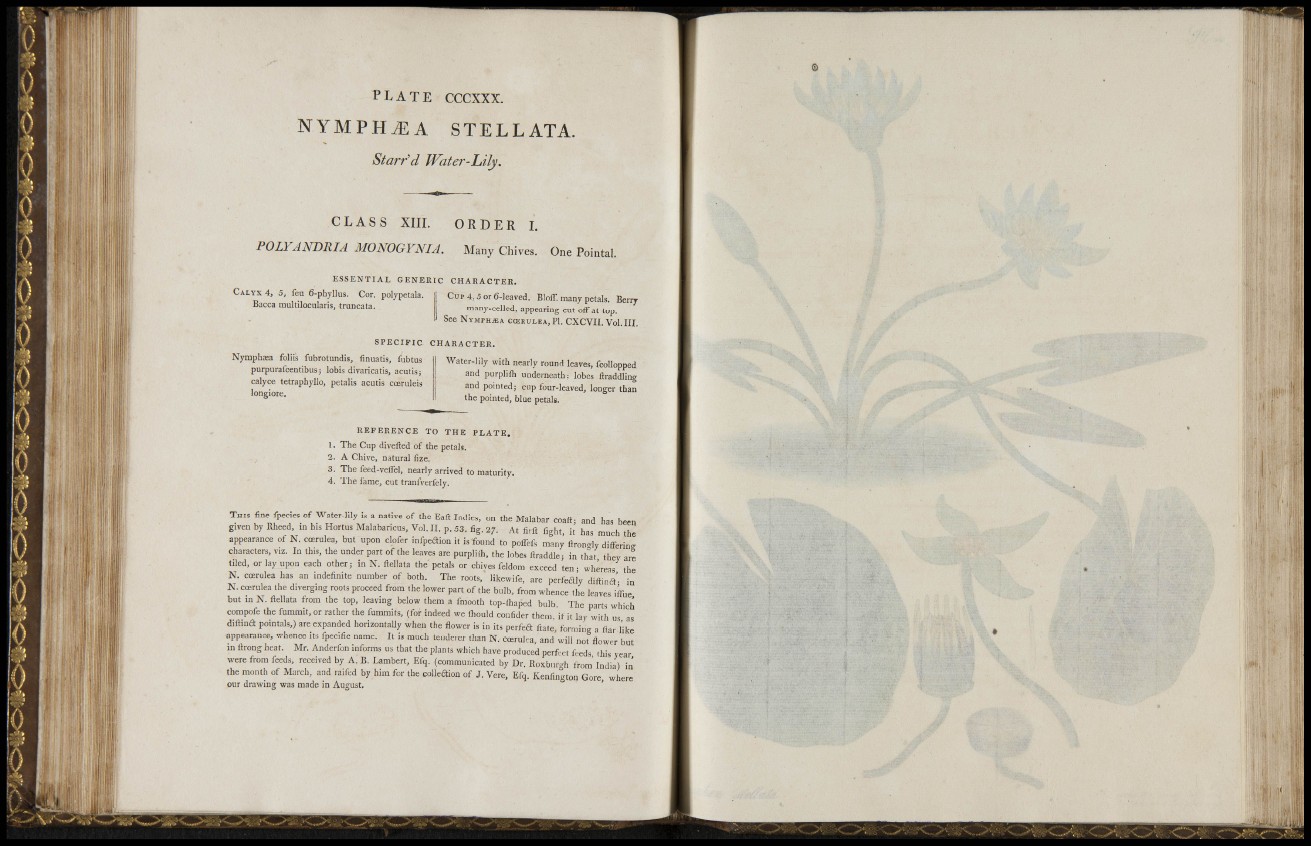
P L A T E CCCXXX.
N Y M P H É A STELLATA.
Starr d Water-Lily.
fiir I
iiii
È I
C L A S S xm. ORDER L
POLYANDRIA MONOGYNIA. Many Chives. One Pointai.
E S S E N T I A L GENERIC CHAEACTER.
CALYX 4, 5, feu 6-phyllus. Cor. polypetala.
Bacca multilocularis, trúncala
CUP 4, 5 or 6-leaved. Bloff. many petals. Berry
many-celled, appearing cut ofF at top.
See NYMPHÉA COERULEA.PI. CXCVI I , Vol.III.
S P E C I F I C CHAEACTER.
Nymphaea foliis fubrotundis, fmuatis, fubtus
purpurafcentibus; lobis divaricatis, acuti.<;;
calyce tetraphyllo, petalis acutis coeruleis
longiore.
Water-lily with nearly round leaves, fcollopped
and purpliih underneath.- lobes ftraddling
and pointed; cup four-leaved, longer than
the pointed, blue petals.
R E F E R E N C E TO THE PLATE.
1. The Cup divefted of the petals.
2. A Chive, natural fize.
3. The feed-veiTel, nearly arrived to maturity.
4. The fame, cut tranfverfely.
THIS fine fpecies of Water-lily is a native of the Eaft Indies, on the Malabar coaft: and has been
given by Rheed, in his Hortus Malabaricus, Vol. II. p. ,53. iig. 27. At firft fight, it has much the
appearance of N. ccerulea, but upon clofer infpeaion it is found to poiTefs many ftron-ly differinir
characters, viz. In this, the under part of the leaves are purpliih, the lobes ftraddle; in th'at thev arc
tiled, or lay upon each other; in N. ftellata the petals or chives feldom exceed ten • whereas the
N. ccerulea has an indefinite number of both. The roots, likewife, are perfeaiy diftina- in
N. ccerulea the diverging roots proceed from the lower part of the bulb, from whence the leaves iffue
but m N. fiellata from the top, leaving below them a fmooth top-lhaped bulb The parts which
compofe the fummit, or rather the fummits, (for indeed we lliould confider thern. it it lav with us as
diftina pointals,) are expanded horizontaUy when the flower is in its perfea ftate, forming a iiar like
appearance, whence its fpecific name. It is much tenderer than N. ccerulea, and will not flower but
in ttrong heat. Mr. Anderfon informs us that tlie plants which have produced perfect feeds this year
were from feeds, received by A. B. Lambert, Efq. (communicated by Dr. Roxburgh from India) in
the month of March, and raifed by him for the colkaion of J. Vere, Efq. JCenfington Gore where
our drawing was made in August. '
• 1